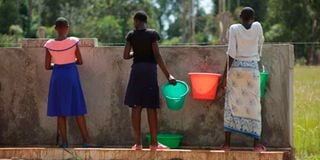Premium
Time to put in place county-specific policies in war on FGM

Girls at a temporary anti-FGM rescue centre in Kuria West, Migori County on December 22, 2021.
What you need to know:
- In Kenya, 21 per cent of women and girls, aged 15-49, have undergone some form of FGM.
- Overall, about four million, or one in five women and girls in Kenya, have been subjected to FGM.
The world comes together every year to celebrate the International Women's Day. This is the day when cultural, political and socio-economic achievements of women are highlighted.
Several vices come to the fore on this day, and female genital mutilation (FGM) stands out. FGM is a retrogressive cultural practice that is common not only in Kenya but Africa and Asia. According to Unicef, FGM in Africa is as high as 98 per cent in Somalia, 96 per cent in Guinea, 93 per cent in Djibouti, 91 per cent in Egypt and 89 per cent in Eritrea.
In Kenya, 21 per cent of women and girls, aged 15-49, have undergone some form of FGM. Overall, about four million, or one in five women and girls in Kenya, have been subjected to FGM. Additionally, an estimated 574,000 Kenyan girls are at risk of undergoing FGM between now and 2030, unless urgent action is taken to prevent it.
Whereas ending FGM is a national priority in Kenya, with an action plan to end the practice by 2022, the practice continues unabated.
At the national level, the legal instruments that protect women and girls’ rights include: The Constitution of Kenya 2010, Children’s Act 2001, Prohibition of Female Genital Mutilation Act 2011, The Penal Code, and Protection Against Domestic Violence Act 2015.
Besides, there are relevant policies on rights of women and girls in Kenya that include the National Policy on Abandonment of Female Genital Mutilation (2010), which provided the platform for the enactment of the Prohibition of FGM Act 2011 and established the Anti- FGM Board as well as The National Adolescent Sexual and Reproductive Health Policy (2012), which classified FGM as a harmful practice with a direct impact on reproductive health and the status of adolescents.
Others are The National Policy for Prevention and Response to Gender Based Violence 2014, which accelerated efforts towards elimination of all forms of gender-based violence (GBV) in Kenya and The National Policy on Gender and Development, 2019, whose overall goal is to achieve gender equality by creating a just society where women, men, boys and girls have equal access to opportunities in the political, economic, cultural and social spheres of life.
Eradication of FGM
The fact that FGM continues amidst these policy and legal instruments calls for a rethink of the strategy to eradicate the vice.
There is a need for integration of FGM into existing health programmes, and collaboration and partnership at all governance levels is critical.
It behoves county governments, especially those in whose jurisdictions FGM is practiced, to come up with county-specific policies to eradicate FGM. Kajiado was the first county to do so in 2019, and the County Government of Tharaka Nithi has taken the cue to develop and launch a robust policy designed to end FGM at the community level.
The policy, which is firmly grounded on the principles of gender equality, inclusivity and non-discrimination, provides the legal framework required to fast-track the eradication of FGM at the county level by creating decentralised governance structures that will be cascaded from the county to the ward level.
It has been developed by the County Government of Tharaka Nithi’s Department of Education, Youth, Culture, Sports and Tourism, in partnership with Plan International and the Government of Kenya.
The vision of its framers is to eradicate FGM and child marriage and improve the quality of life for women and girls in Tharaka-Nithi.
Its specific objectives are to create awareness to the community aimed at accelerating abandonment of FGM; to ensure survivors of FGM and child marriage receive necessary medical treatment and psychosocial support; to strengthen the existing multi-sectoral coordination, collaboration, partnerships and networking for eradication of FGM; to address gender inequality associated with FGM by promoting empowerment of girls and women; and to promote community dialogues in the campaign against FGM.
Other specific objectives are to set up a robust data, information and knowledge management system to aid in research, analysis and reporting of emerging dynamics of FGM; and to ensure survivors of FGM and child marriage are assisted to access justice.
Outdated cultural practice
The policy, which was adopted by the Tharaka Nithi County Assembly in May 2021, allows the county government to allocate funds for the war against the outdated cultural practice that deals a great blow to health, social and economic welfare of the girl child and the society at large.
It contains a raft of measures, including formation of Ward Anti-FGM Policy committees to spearhead the fight from the village level.
For Tharaka-Nithi County, this policy could not have come at a better time.
According to the Kenya Demographic Health Survey (KDHS) 2010, the prevalence rate in Tharaka Nithi County in 2009 stood at 58 per cent among girls aged between seven and 17 years and 95 per cent among women aged above 50 years, which was one of the highest in Kenya compared to the national average of 21 per cent. A 2017 report by Unicef shows that 71 per cent of women aged 15-49 years in Tharaka Nithi County had experienced some form of FGM.
Whereas countries may pass laws to eradicate FGM, legal instruments by themselves cannot end the practice since traditions and beliefs are strong and deeply rooted in societies.
In order to eradicate a culturally embedded practice such as FGM, legal action must be combined with initiatives that bring about changes in these beliefs and attitudes.
County-specific policies form part of these initiatives.
The writer is Country Director at Plan International Kenya





